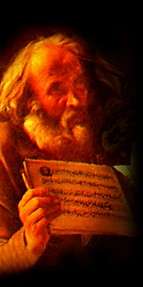 |
 |
 |
 |
 |
|
| COLLAGE TECNIQUE |  |
|
Pärt has stated that his collages "were an attempt to replant a flower in alien surroundings (the problem of the suitability of tissue; if they grow together into one, the transplantation was the right move). Here, however, the idea of transplantation was not in the foreground - I wished rather to cultivate a single flower myself." 2 More specifically, Pärt's collage technique involved the insertion of borrowed musical material, from composers such as Bach and Tchaikovsky, into his serial structure. This material included not only small quotations but also larger sections of basically unaltered music of various 17th through 19th century composers. However, while the collage technique added elements of traditional tonality to his compositions, the basic integral dodecaphonic structure remained the same.
Scored for strings, oboe, harpsichord and piano, the Collage sur B.A.C.H. was one of the first compositions using the collage technique. The second movement introduces a Bach sarabande for oboe and harpsichord which is later interrupted by violent piano tone clusters. An unexpected quotation from Tchaikovsky's "Album for Children," Süsser Traum, provides a calming conclusion to the terrifying and tragic Second Symphony. Pro et contra contains no direct quotations but only Pärt's own characterizations of the Baroque style. The Credo for piano, orchestra and chorus proved to be the final composition in Pärt's transitional phase. The choral/orchestral opening of the piece is authentically Baroque in style and eventually gives way to a direct quotation (solo piano) from Bach's C major Prelude from the Well-tempered Clavier. As in the introduction, this passage contains grand, choral interjections. Gradually, the music becomes faster and more frenzied until it finally erupts into violent chaos.
Following this middle section, the piano re-introduces the C major Prelude while the chorus returns to the baroque-like passages from the introduction. In Credo, Pärt employs choral whispering and unconventional notation (e.g., stemless notes in the section marked feroce). The most radical technique used in this piece, however, pervades not only the choral Pärts but also the entire orchestra. It is a form of improvisation for which Pärt specifies the pitch ranges and nothing else. The performers can sing or play any notes, of any length, during those measures – as long as they remain within the indicated pitch ranges. 3
After composing the Credo of 1968, Pärt entered a period of creative silence which he used for the study of medieval music. More specifically, he studied Notre Dame organum and the choral music of French and Franco-Flemish composers such as Machaut, Ockeghem, Obrecht and Josquin. After this period of silence, he re-emerged in 1971 with his Symphony No. 3, which differs significantly from any previous work. The polyphonic structure can be traced to Dutch polyphony,
and contains both elements of the medieval and the classical periods, in the respective areas of melody and rhythm. Unlike any previous work, the musical language is entirely tonal. In this piece, serialism has been abandoned for a more peaceful and introspective approach. 4 However, Pärt was not yet prepared to abandon his search for his true compositional voice. In 1972, he composed a symphonic cantata, Lied an die Geliebte, and then entered again into a period of silence. Pärt re-emerged four years later, having found the voice for which he had been searching.
©1996 David E. Pinkerton II
|
2 Merike Vaitmaa, liner notes for Arvo Pärt, Cello Concerto "Pro et Contra"; Perpetuum Mobile; Symphony No. 1, "Polyphonic"; Symphony No. 2; Symphony No. 3, Bamberg Symphony Orchestra, Neeme Järvi, (BIS CD-434).
3 Schenbeck, "Discovering the Music of Estonian Composer Arvo Pärt," 23.
4 Sandner, liner notes for Arvo Pärt Tabula Rasa.
5 Sandner, liner notes for Arvo Pärt Tabula Rasa.
|
|
|
|

